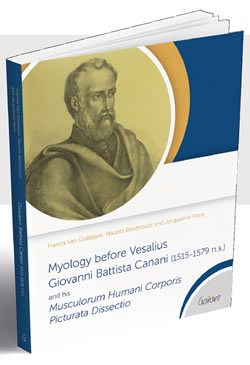Book cover
[UPDATED 11/30/2023] This is a book published recently by my good friends Francis Van Glabbeek, Maurits Biesbrouck, and Jacqueline Vons.
This group is dedicated to the works of Andreas Vesalius and his influence on Medicine, Surgery and the Arts. As part of the analysis of Vesalius’ works they started research on a far less-known anatomist, Giovanni Battista Canani (1515 - c.1579). Cananis’ last name is sometimes presented as Canano.
The authors researched a book of which there are only 15 known copies in the world, far less than Vesalius’ Fabrica, "Musculorum Humani Corporis Picturata Dissectio". Of these 15 copies, only two are in the USA, one at Yale University, the other at Duke University. The online version of the Duke University can be seen or downloaded here.
Canani was born in Ferrara, Italy and was a remarkable and leading physician-anatomist in the sixteenth century, but he is far less well known today than contemporaries such as Vesalius, Fallopio or Colombo.His only work on the muscular anatomy of the upper limb Musculorum Humani Corporis Picturata Dissectio (Dissection Images of the Muscles of the Human Body) can in fact be considered as a masterpiece of its time, no less innovative than Vesalius’ Fabrica. The book is revolutionary in its content and contains copper etchings of exceptional quality and precision. This is the result of Canani’s extensive dissections of human corpses, performed meticulously and with a determination to discover the tiniest details of the human anatomy.
In fact, Canani came from a distinguished medical family and developed into an anatomist at an early age. He was trained by Marcantonio della Torre, an associate of Leonardo da Vinci, and was Pope Julius IIIs personal physician until his death in 1555, after which he became chief physician at the University of Ferrara. He discovered the palmaris brevis muscle in the hand and was the first to describe the valves in the veins, a fact which he communicated to his contemporary, Vesalius. Around 1542, he published a small volume of twenty leaves on the muscles of the arm and forearm. This was to be the initial book of may be a larger work he planned to produce; however, it was the only book that was completed. It is thought that he felt his work was so overshadowed by Vesalius' Fabrica that he destroyed as many copies as he could recover. This would explain the scarcity of copies of Canani’s original book.
Thankfully, the book by Van Glabbeek, Maurits Biesbrouck and Jacqueline Vons contains a color facsimile of Cananis’ publication and should be a fantastic addition for any student of Medical History or collector of Vesaliana. You can order your copy by clicking here or use the QR code in this article.

Professor Francis Van Glabbeek, anatomist and surgeon, founding member and member of BIOMAB (Biological and Medical Art in Belgium), is a passionate collector of antiquarian medical books, has been a driving force in continuing Vesalius’s legacy by bringing artists together with scientists, and, in the spirit of Vesalius, teaching anatomy from direct observation.
Maurits Biesbrouck is a well known Vesalius scholar who published a Dutch translation of the first volume of the 1543 Fabrica by Vesalius, as well as a Vesalius bibliography as well as a summary and discussion of the editions of his works.
Jacqueline Vons is Professor Emeritus of classical languages at Université François Rabelais in Tours, France. Together with Prof. Stephane Velut, Professor of Anatomy at the same university, she published the first French translation of Vesalius’s Epitome and is currently working on the French translation of Vesalius’s 1543 Fabrica.
Personal note: In June, 2023 I was invited by the University of Antwerp to present at the 2023 Vesalius Triennial Meeting. I used the opportunity to have Professor Francis Van Glabbeek sign my copy of his book, which is now part of my library. Dr. Miranda.
Sources:
1. “Myology before Vesalius - Giovanni Battista Canani (1515 - 1579 n.s.) and his Musculorum Humani Corporis Picturata Dissectio " Van Glabbeek,F; Biesbrouck, M.; Vons, J. 2022. Garant, Belgium.
2. "Musculorum Humani Corporis Picturata Dissectio" Sigersit, HE. 1925 Lier & Co. Florece, Italy.




